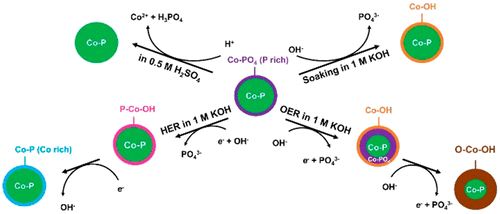当前位置:
X-MOL 学术
›
J. Phys. Chem. C
›
论文详情
Our official English website, www.x-mol.net, welcomes your
feedback! (Note: you will need to create a separate account there.)
Elucidating Surface Restructuring-Induced Catalytic Reactivity of Cobalt Phosphide Nanoparticles under Electrochemical Conditions
The Journal of Physical Chemistry C ( IF 3.3 ) Pub Date : 2018-01-26 00:00:00 , DOI: 10.1021/acs.jpcc.7b11843 Zishan Wu 1, 2 , Quan Gan 1, 2, 3 , Xiaolin Li 1, 2, 4 , Yiren Zhong 1, 2 , Hailiang Wang 1, 2
The Journal of Physical Chemistry C ( IF 3.3 ) Pub Date : 2018-01-26 00:00:00 , DOI: 10.1021/acs.jpcc.7b11843 Zishan Wu 1, 2 , Quan Gan 1, 2, 3 , Xiaolin Li 1, 2, 4 , Yiren Zhong 1, 2 , Hailiang Wang 1, 2
Affiliation

|
Probing and understanding surface restructuring-induced electrocatalytic reactivity is an essential but challenging step toward rational prediction of electrocatalytic properties and design of high-performance catalysts. Cobalt phosphide (CoP) nanoparticles are state-of-the-art electrocatalysts for both the hydrogen evolution reaction (HER) and the oxygen evolution reaction (OER). However, the structure–reactivity correlations are not straightforward because the nanoparticles will restructure under working conditions. Employing a protective sample transfer procedure, we use simple lab XPS to unveil the changes in oxidation state and composition of the nanoparticle surface induced by electrochemical reaction conditions. CoP nanoparticles are naturally oxidized on their surface. In alkaline electrolyte under HER conditions, a Co-rich phosphide surface is generated as a result of polyphosphate dissolution and reduction of the oxidized P and Co species. In alkaline electrolyte under OER conditions, an oxidation and dissolution process occurs, and the surface evolves into hydroxide/oxide with a subtle amount of phosphate residue. In acidic electrolyte under HER conditions, the surface oxidation layer is dissolved by the electrolyte, and a fresh CoP surface is exposed. These surface restructuring results help rationalizing the electrocatalytic reactivity of CoP nanoparticles for water splitting under various electrochemical conditions.
中文翻译:

阐明在电化学条件下表面重组诱导的钴磷酸盐纳米颗粒的催化反应性
探索和了解表面重组诱导的电催化反应性是朝着合理预测电催化性能和设计高性能催化剂迈出的重要但具有挑战性的一步。磷化钴(CoP)纳米颗粒是用于析氢反应(HER)和析氧反应(OER)的最先进的电催化剂。但是,结构与反应性之间的关系并不直接,因为纳米粒子会在工作条件下发生重组。采用保护性样品转移程序,我们使用简单的实验室XPS揭示了电化学反应条件引起的纳米颗粒表面氧化态和组成的变化。CoP纳米颗粒在其表面自然氧化。在HER条件下的碱性电解液中,由于多磷酸盐的溶解以及氧化的P和Co物种的还原,生成了富含Co的磷化物表面。在OER条件下的碱性电解质中,会发生氧化和溶解过程,并且表面演变为氢氧化物/氧化物,并带有少量的磷酸盐残留物。在HER条件下的酸性电解质中,表面氧化层被电解质溶解,并且新鲜的CoP表面被暴露。这些表面重构结果有助于合理化CoP纳米颗粒在各种电化学条件下用于水分解的电催化反应性。并且表面演变为氢氧化物/氧化物,并带有少量的磷酸盐残留物。在HER条件下的酸性电解质中,表面氧化层被电解质溶解,并且新鲜的CoP表面被暴露。这些表面重构结果有助于合理化CoP纳米颗粒在各种电化学条件下用于水分解的电催化反应性。并且表面演变为氢氧化物/氧化物,并带有少量的磷酸盐残留物。在HER条件下的酸性电解质中,表面氧化层被电解质溶解,并且新鲜的CoP表面被暴露。这些表面重构结果有助于合理化CoP纳米颗粒在各种电化学条件下用于水分解的电催化反应性。
更新日期:2018-01-26
中文翻译:

阐明在电化学条件下表面重组诱导的钴磷酸盐纳米颗粒的催化反应性
探索和了解表面重组诱导的电催化反应性是朝着合理预测电催化性能和设计高性能催化剂迈出的重要但具有挑战性的一步。磷化钴(CoP)纳米颗粒是用于析氢反应(HER)和析氧反应(OER)的最先进的电催化剂。但是,结构与反应性之间的关系并不直接,因为纳米粒子会在工作条件下发生重组。采用保护性样品转移程序,我们使用简单的实验室XPS揭示了电化学反应条件引起的纳米颗粒表面氧化态和组成的变化。CoP纳米颗粒在其表面自然氧化。在HER条件下的碱性电解液中,由于多磷酸盐的溶解以及氧化的P和Co物种的还原,生成了富含Co的磷化物表面。在OER条件下的碱性电解质中,会发生氧化和溶解过程,并且表面演变为氢氧化物/氧化物,并带有少量的磷酸盐残留物。在HER条件下的酸性电解质中,表面氧化层被电解质溶解,并且新鲜的CoP表面被暴露。这些表面重构结果有助于合理化CoP纳米颗粒在各种电化学条件下用于水分解的电催化反应性。并且表面演变为氢氧化物/氧化物,并带有少量的磷酸盐残留物。在HER条件下的酸性电解质中,表面氧化层被电解质溶解,并且新鲜的CoP表面被暴露。这些表面重构结果有助于合理化CoP纳米颗粒在各种电化学条件下用于水分解的电催化反应性。并且表面演变为氢氧化物/氧化物,并带有少量的磷酸盐残留物。在HER条件下的酸性电解质中,表面氧化层被电解质溶解,并且新鲜的CoP表面被暴露。这些表面重构结果有助于合理化CoP纳米颗粒在各种电化学条件下用于水分解的电催化反应性。


















































 京公网安备 11010802027423号
京公网安备 11010802027423号